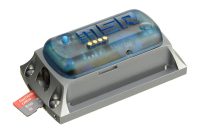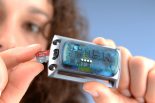MSR165 Data Loggers assist with Machine, Workpiece and Production Optimisation
MSR165, a mini data logger the size of a thumb, can be used in many areas of physical and electrical measurement technology, in order to record 3-axis acceleration, air pressure, humidity, temperature, light and many other arbitrary voltage values. Please find below a practical example from the industry, which illustrates how useful these small measured data recorders can be.
At its St. Wendel site, the Fresenius Medical Care Company manufactures peritoneal dialysis systems, which can be used to perform extremely gentle blood purification on patients. These highly complex electronic medical devices require special plastic valves that must be manufactured and installed in a cleanroom, in compliance with the effective regulations. In the production machines used for the installation work, these valves are transported on workpiece carriers that are machined from polyethylene terephthalate (PET) solid material. However, due to the permanent mechanical stress, signs of wear appeared on the workpiece carriers; therefore, the decision was taken to develop a new, more hard-wearing design.
Precise recording of dynamic mechanical stress
 In the first instance, the development of a new variant of the workpiece carriers was based on an extensive series of measurements, which was carried out by Daniel Klein, a student at the sub-department of Polymer Materials at Saarland University, within the context of his bachelor thesis. Initially, workshop data and load measurements served as the basis for the analysis and evaluation of the existing solution. They were evaluated and translated into tensile stress using the finite element method (FEM). This supplied information on the suitability of the current workpiece carriers with regard to the demands made of them during operation and, therefore, provided baseline data for developing a more optimised solution. In this context the measurement of the dynamic mechanical stress, which the workpiece carriers are subjected to, was crucial. For this purpose, an MSR165 data logger by the Swiss manufacturer MSR Electronics was screwed onto a workpiece carrier (image 1) during the series of measurements and – like the other workpiece carriers containing the valves – introduced into the actual production cycle of the machines.
In the first instance, the development of a new variant of the workpiece carriers was based on an extensive series of measurements, which was carried out by Daniel Klein, a student at the sub-department of Polymer Materials at Saarland University, within the context of his bachelor thesis. Initially, workshop data and load measurements served as the basis for the analysis and evaluation of the existing solution. They were evaluated and translated into tensile stress using the finite element method (FEM). This supplied information on the suitability of the current workpiece carriers with regard to the demands made of them during operation and, therefore, provided baseline data for developing a more optimised solution. In this context the measurement of the dynamic mechanical stress, which the workpiece carriers are subjected to, was crucial. For this purpose, an MSR165 data logger by the Swiss manufacturer MSR Electronics was screwed onto a workpiece carrier (image 1) during the series of measurements and – like the other workpiece carriers containing the valves – introduced into the actual production cycle of the machines.
Recording the acceleration 1,600 times per second
This logger of the MSR165 model series is a data acquisition/storage system, which works self-sufficiently in long-term operation, recording the information on microSD cards. The current version is equipped with a high-resolution, extremely sensitive 3-axis digital accelerometer. Both its small size (39 x 23 x 72 mm, approx. 64 g) and the facility to record acceleration in three axes, make this logger extremely suitable for the task given by Fresenius Medical Care.
 The sensor technology is installed in an anodised, waterproof aluminium case. Ultimately, this robust logger is capable of making up to 1,600 acceleration (shock, vibrations) measurements per second in all three axes, with a 13 bit digital resolution of the measured values. At the same time temperature, humidity, pressure and light can also be recorded. The installed memory of the logger is capable of storing over 2 million measured values, which is sufficient for more than 10,000 shocks. If a larger memory is required, the capacity of the logger can be increased to approx. 1 billion measured values by using a microSD card (≥4 GB). The MSR165 realises the demand of many engineers for a measuring frequency in excess of 1 kHz in the field of shock measurements, where maximum acceleration measurements of up to +/-15 g can be recorded – a measuring range frequently required by users.
The sensor technology is installed in an anodised, waterproof aluminium case. Ultimately, this robust logger is capable of making up to 1,600 acceleration (shock, vibrations) measurements per second in all three axes, with a 13 bit digital resolution of the measured values. At the same time temperature, humidity, pressure and light can also be recorded. The installed memory of the logger is capable of storing over 2 million measured values, which is sufficient for more than 10,000 shocks. If a larger memory is required, the capacity of the logger can be increased to approx. 1 billion measured values by using a microSD card (≥4 GB). The MSR165 realises the demand of many engineers for a measuring frequency in excess of 1 kHz in the field of shock measurements, where maximum acceleration measurements of up to +/-15 g can be recorded – a measuring range frequently required by users.
As a g-analysis often requires knowledge of the history of the “shock”, this logger can record 32 measured values even before the event takes place. As a result, the user not only knows that a shock has occurred but also identifies the exact development of the shock in the three axes.
Thanks to its 900 mAh lithium-polymer battery the unit could ultimately monitor the acceleration over a period of up to six months, provided the measurement frequency was appropriately adjusted. However, in the concrete case in question this was no more necessary than the recording of the temperature, humidity, pressure, light or any analogue input voltages.
Uncovered: wear due to shock acceleration
 As the tension-related design of plastic components is in principle independent of the nature and duration of the stress, in this case it was sufficient to use the logger to analyse the maximum (shock) load when investigating the workpiece carriers. This way, the acceleration trend as the workpiece carriers were advanced in the processing machine with jerky movements, could be identified during the series of measurements.
As the tension-related design of plastic components is in principle independent of the nature and duration of the stress, in this case it was sufficient to use the logger to analyse the maximum (shock) load when investigating the workpiece carriers. This way, the acceleration trend as the workpiece carriers were advanced in the processing machine with jerky movements, could be identified during the series of measurements.
Here the acceleration was mostly within the +/-2 g range (image 2). Vibrations and shocks, which had previously been unnoticed by camera shots, were now detected. Ultimately it was the MSR data logger that facilitated the exact quantification of the dynamic loads during operation. In this way, operational issues due to signs of wear as a result of the shape and weight of the workpiece carriers were detected. From now on these issues can be avoided, as can the maintenance work resulting from the signs of wear, by implementing an optimised physical design for new workpiece carriers in the future.
The data loggers of the MSR165 model series record a number of physical measurands, including the acceleration, at a frequency of up to 1,600/s in all three axes. Here, such a data logger the size of a thumb has been mounted onto a workpiece carrier in order to determine the mechanical stress of the latter when running through a production machine cycle.
Daniel Klein / Gabriela Zumkehr
Can we also help you with your measuring tasks? We would be pleased to advise you!
 Deutsch
Deutsch



